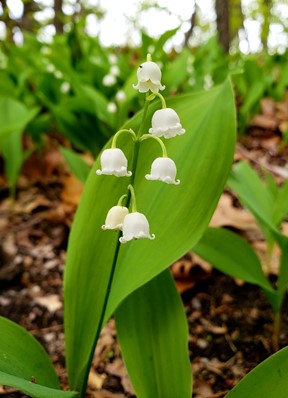 Convallaria
majalis
Convallaria
majalisLily of the Valley This European native plant was first cultivated in 1420 and is beloved by the Fae and humans alike. It is sometimes called Fairy Cups, because the flowers look like cups the fairies have hung up while dancing. The flowers are said to ring when fairies sing and to form ladders fairies use to reach reeds from which they weave their cradles. Obviously, this is a good plant for attracting the Folk to your magickal garden. According to folklore, this plant blooms on the grave of someone who was executed for a crime they did not commit. It is thought that planting them in the garden will protect the home from ghosts and evil spirits. Although some people consider it bad luck to bring the flowers into the house, in France, people still trade gifts of this plant on May Day in order to have good luck through the year. The scent of this flower is said to attract nightingales and to give people the power to see a better world. In the language of flowers, lilies-of-the-valley represent the return of happiness. They are generally a symbol of humility, purity, and sweetness.
In Mythology This plant is connected with Maia, the oldest of the Seven Sisters and the goddess of growth, increase, fields, and spring. She and Zeus are the parents of Hermes (Mercury), and so she is the grandmother of magick, which was invented by her son Hermes (pic shows family snapshot of Maia, Zeus, and Hermes at home). The month of May is named for her, and the 1st and 15th of May are her sacred days. Her worship survives as the celebration of the Queen of May in the Catholic church. In the past, only women were allowed to worship Maia. In ancient Rome, May was a time of purification and religious rituals, so it was a very unlucky month to get married (pretty interesting considering that nowadays lilies-of-the-valley are a standard in the bridal bouquet and represent marital longevity). TopIn Magick Lily of the valley is associated with Gemini because of the Mercury connection. Gemini rules divination and summoning, and since Mercury rules magick, this is a good plant to use for ceremonial magick or divination (even though it is not Moon, the usual choice for divination). You could make a great oil for aiding divination by macerating (soaking) the flowers in almond or olive oil. Make a number of macerations in the same oil to get a good buildup of scent. The lily of the valley perfumes commonly available are made from synthetics. Growing the plant is the only way to acquire a natural perfume of the flowers. Top
In Herbalism Considered a Mercury herb, lily of the valley was in the past used for illnesses of the head or brain, such as melancholy, depression, epilepsy, and stroke. Its decoction was mixed with lavender and peppercorns and spread on the forehead and back of the neck to bring someone to their senses. However, later it became much used as a far less poisonous substitution for foxglove and applied to heart disease. Historically, Germans have made a raisin wine with some of the flowers. This demonstrates that although the plant is toxic, the poison is poorly absorbed. The sap can be a skin irritant, however. Leaves of this plant furnish a green dye in spring and yellow in autumn. TopIn the Garden The sweet, bee-attracting flowers appear in May; folk belief says plant tomatoes when you see them appear. It makes a great groundcover around shrubs, especially under lilacs (blooms at the same time). This is a good plant for the corners of your house, where nothing else will grow. It produces berries but reproduces mainly through creeping rhizomes. This plant is also known as Little Maybells, Mary's Tears, Our Lady's Tears, Ladder to Heaven, Jacob's Tear, May Lily, and Male Lily. Top
How to Grow Lily of the Valley These seeds must be cold stratified. Check out the Making Winter page. Wet a paper towel, wring out, sow seeds in towel, fold, and put in baggie in fridge for 4-8 weeks. Some people freeze the seeds, which is said to increase the length of viability. (We have not tried this but it does get very cold here in winter and we regularly find these plants growing in new places.) Take seeds out and sow, barely covering. Cold-stratified seeds germinate better when they get light. Or just plant outside in fall. This seed is a good candidate for the soaking method - soak seeds in cold water in the fridge for two weeks, changing for fresh water daily. Take out and plant. These seeds don't have any Mercury speediness in their growth - they can take 2 months or more to germinate. Grow them in a pot and give them winter protection the first year, then put them in the ground in rich, moist soil and shade or dappled shade. They won't bloom if they get too much sun or are too dry, but they can grow in heavy clay and full shade. They are hardy to zone 6 (-10F/-20C) and are rabbit-proof. They spread by creeping rhizomes and sometimes can be invasive. Once they are established, divide them in September. General growing info Top
|
Convallaria majalis
Uses in Magic & Witchcraft: Fairy Magic |
Alchemy Works products are offered for use in spiritual, ritual, meditative, and magical practices, not for medicinal or cosmetic purposes. The information on this website is provided for its folkloric, historic, and magical value. It is not intended to be a substitute for professional medical advice, diagnosis, or treatment.
